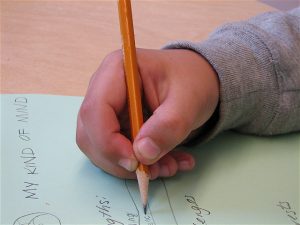
Photo from Elizabeth Lloyd (CC BY 2.0) Flickr
As my own knowledge grows about children’s development, I have noticed a continued decrease in fine motor skills in children entering Kindergarten. There are as many theories suggesting the causes as there are suggestions for parents and educators to help develop these skills. However, non-educators may only have a general idea of fine motor skills and what part of the body they entail.
The Victoria State Government, in Australia, has an extensive website dedicated to their schools which includes learning support for their early years programs. An article in the Literacy Teaching Toolkit directly defines fine motor skills as: “Fine motor refers to the group of skills involved in the ability to manipulate smaller objects with the hands and fingers, for example, grasping, holding, and pinching.”
It is important to recognize that fine motor skills are not only necessary for writing and drawing but they are also directly related to getting dressed, doing up buttons and zippers, tying shoes, eating, and brushing teeth. Without direct teaching for children who come to kindergarten with lower fine motor abilities, the longer it takes them to become proficient in general care for themselves.
This article begins with the child learning to support their whole arm, then their whole hand, and then moves on to explain two different pincher grips. Without first beginning with supporting the whole arm, it will be trickier for the child to learn the correct pincher grip. As an educator, it is important for me to meet the child where they are and make sure they have the necessary prior skills before learning a new one.
The most applicable information the article supplies is the suggestions provided to develop fine motor skills. As professionals, we understand that it can take time for children to be observed by occupational therapists. This article provides activities that you can do in your classroom or outdoor space that support all children and especially those who need more development. Not only does it provide suggestions, but the activities are linked to lesson plans and/or videos.
This website is a fabulous resource for any early years educator looking to increase fine motor activities in their classroom or play space. I also appreciate that the article is supported with theory and evidence-based research. Check it out here:

Thanks for sharing this resource! Do you think that we are seeing a decrease in fine motor skills because children are having less of these experiences at home? Perhaps there is a connection to how technology is being used at home (example- children playing more on tablets instead of activities such as arts and crafts). This would be interesting to research!
Thank you for sharing this article! I can relate to what you’re saying, I have a few children who struggle with fine motor skills and I’ve been struggling to find ways to best support them. I’ve been on the hunt for some good ideas, and this article provides enough that I can start using tomorrow. In my class I observed a range of abilities, and the majority of my grade one class struggles with their pencil grip!! I plan to use the ideas listed in the article as a station for my literacy block! I’ll let you know how it goes ;).